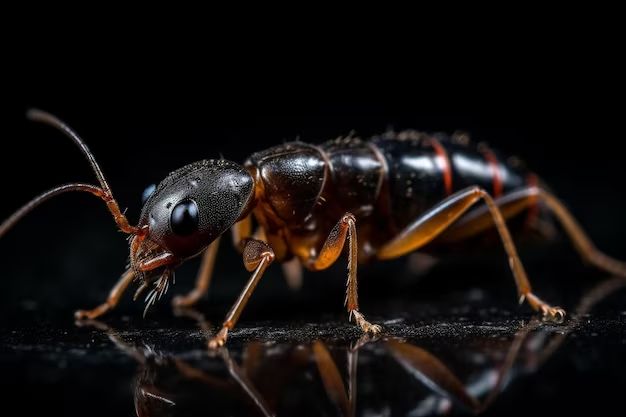Ants come in many different shapes, sizes, and colors. Most ants appear black or brown to the naked eye. However, some species have more distinctive markings, like stripes. There are a few different types of ants that can have striped appearances.
Page Contents
Tiger Ants
One of the most well-known striped ants is the tiger ant. There are several species that fall under this common name, such as the Asian weaver ant and the yellow crazy ant. Tiger ants are typically black or dark brown in color with pale yellow or white stripes on their bodies and legs. They get the name “tiger” from their striped pattern that resembles a tiger’s markings.
Asian Weaver Ant
The Asian weaver ant (Oecophylla smaragdina) is found throughout tropical southern Asia, Australia, and some Pacific islands. They are large ants, measuring around 5-15 mm long. Their head and abdomen are black, while their thorax is a reddish-brown color. Distinctive yellowish-white bands wrap around their abdomen and legs. These ants are known for being highly territorial and having a painful sting.
Yellow Crazy Ant
Yellow crazy ants (Anoplolepis gracilipes) are another type of tiger ant found across the tropics. Their body is black or dark brown with bright yellow stripes along the abdomen and legs. Their common name comes from their quick, erratic movements when disturbed. Yellow crazy ants can form supercolonies containing millions of individuals and are considered an invasive pest species.
Pavement Ants
Pavement ants belong to the genus Tetramorium, a group of more than 400 species of ants. Many Tetramorium ants have striped appearances. For example, the European pavement ant (T. caespitum) has a brown or black head and thorax with pale yellowish markings on the abdomen. The stripes may be broken or irregular but help distinguish them from other ant species.
Key Features
- Black, brown, or reddish head and thorax
- Striped abdomen with pale bands
- Small to medium sized, around 2-5 mm long
- Build nests under stones, pavement, etc
Pavement ants are native to Europe but have spread to many other parts of the world through human transportation and commerce. They can thrive in urban environments.
Honeypot Ants
Honeypot ants in the genus Myrmecocystus have a striped look caused by the enlarged abdomens of repletes. Repletes are workers that are fed until their abdomen swells to store food reserves. Their swollen back portion will look pale compared to the rest of their darker body and create a striped effect.
Key Features
- Enlarged pale abdomen on replete workers
- Regular workers are black or brown
- Live in arid climates like deserts
- Build underground nests
Repletes hanging in chamber walls are a distinctive feature of honeypot ant nests. There can be hundreds or thousands of repletes in a mature colony. Their bodies can swell to the size of small grapes when filled with liquid food.
Other Striped Ants
There are a few other ants that may have striped markings such as:
- Acrobat ants – Various Technomyrmex and Crematogaster species have yellow bands on a dark body.
- Timid ants – The timid anteater ant (Basiceros manni) has a striped orange and black abdomen.
- Honey ants – Some honey ant workers have pale or yellow abdomens that contrast with the rest of their body.
However, most of these stripped ants are rarer than tiger ants, pavement ants, and honeypot ants. The bold striped appearance helps camouflage tiger ants in the forest, mimic wasp markings to deter predators, and even reflect heat in hot environments like deserts.
Conclusion
In summary, some of the most common and recognizable striped ants belong to the tiger ants, pavement ants, and honeypot ants. Their distinctive markings come from combinations of contrasting colors on the legs, thorax, and enlarged abdomens. Striped ants use their patterns as warning signals to predators or as a way to reflect sunlight in hot climates. Their stripes arise through a combination of physical and behavioral adaptations over time.
